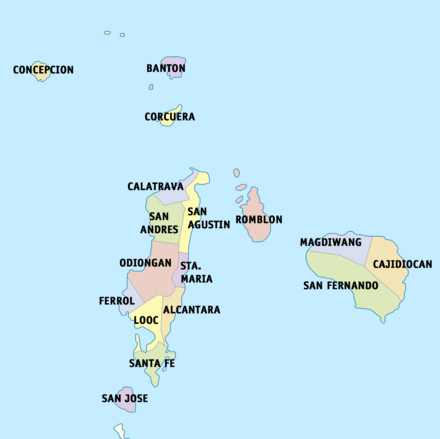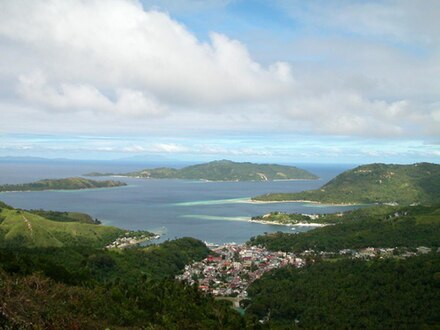Romblon - province of the Philippines
Romblon is an archipelago province of the Philippines. It is located in the middle of the small Sibuyan Sea which separates Luzon from the Visayas.
 The economy is mainly based on farming and fishing, but tourism — especially for diving — is gradually becoming more important.
The economy is mainly based on farming and fishing, but tourism — especially for diving — is gradually becoming more important.
Nearby islands are Mindoro to the west, Marinduque to the north, Masbate to the east, Panay and Boracay to the south. Mindoro, Marinduque and Romblon are all in the administrative region of Mimaropa, which in turn is part of the Luzon region.
Regions
The province includes many islands. Tablas on the west is the largest, and Sibuyan on the east second. In the middle is Romblon Island.
Carabao Island, also known as the municipality of San Jose, is off the southern tip of Tablas and is close to the highly-developed resort island Boracay. It has fine beaches and is being developed for tourism.
Towns

The capital, Romblon Town, is on the north coast of Romblon Island. Alacantra, on the east coast of Tablas Island, has the airport.
Other destinations
Understand
One-letter towns
If you are wondering why locals in each town in Romblon have last names beginning with the same letter (e.g. R in Romblon town, thus there are the Romeros, Ramoses, Reyeses, etc.), this is a result of a colonial decree that mandated Filipinos to adopt a surname. Historically, the people in Romblon do not have surnames, and in 1849, they were required to adopt one from an official catalog for taxation and record-keeping purposes; the decree also states the inhabitants of each town must have a surname beginning with the letter assigned to each settlement by the colonial administrators. In Romblon, it was strictly enforced. You might know where someone in the province came from by just taking the first letter of their last name.
Romblon's name derive from a corruption of the Romblomanon word nagalumyom, referring to the act of how a hen sits over its eggs, but local historians argue it is from Spanish ronblon (screw) or doubloons.
While administratively part of the Tagalog-majority Mimaropa region, the people of Romblon are more closely related to those in the Visayas than to the Tagalog. People of Romblon belong to the Romblomanon, Inonhan and Asi ethnic groups and have their own languages, that are part of the Visayan subgroup.
The archipelago's economy is mostly dependent on agriculture and fishing. Also another source of local income is Italian-quality marble extracted from the islands' mountainous interior. Ecotourism is an emerging industry, but tourists are few and far in between. Most items sold in the island has to be shipped from Luzon or Mindoro, and can be expensive.
Get in
By plane
- Tablas Airport (IATA: TBH). Served by a thrice-weekly Cebgo flight from Manila. 2020-09-10
By ferry
- Romblon Shipping Lines. Operates a ferry from Manila and Masbate to Romblon Island. 2020-09-10
- Montenegro Shipping Lines. Ferries from Batangas City to Romblon town. 2020-09-10
- 2GO Travel. Operates a ferry from Batangas City to Romblon 2/3x weekly, and from Roxas City. 2020-09-10
- Starhorse Lines. Operates ferries from Dalahican port in Lucena, Quezon, with stops at Kawit (in Marinduque) to Banton, San Agustin, Romblon town, and Sibuyan Island, twice weekly. 2020-09-10
- There are also motorboats from Dangay port in Roxas, Mindoro to Odiongan
- Ferries also connect Tablas with Caticlan port in Panay.
Get around
There are jeepney and buses to and from San Agustin to Odiongan (two hours). and from Odiongan to Looc (two hours).
The best way to see Tablas is by motorcycle. The roads are good quality and traffic is light. Bikes can be hired from
See
The two forts of San Andres and Santiago hill, built by the Spaniards in 1640.
Do
The province is popular as a diving destination; see Diving in the Philippines#Romblon.
Buy
- PNB. Ramon Magsaysay St, Romblon town. Has an ATM that accepts Visa.
Eat
Drink
Sleep
- Muravin Hotel. Muravian St, Romblon. From a night.
- Haliwood Inn. Laurel St, Odiongan. from a night.
- August Inn. Faigao St, San Agustin. From a night.
- Vickys Place. Magdiwang. From a night.
- Angeilque Inn. Looc. From a night
Stay safe
There is little in the way of crime and natural hazards in Romblon, but the province does get stuck by typhoons during the rainy season. Rural poverty is widespread. Roads are not congested, but motorbike crashes are not uncommon.
Go next
Romblon
romblonparadise.comMimaropa
Primary administrative division